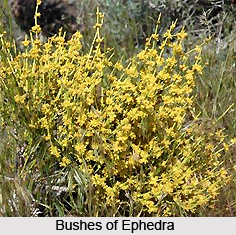The Ayurvedic name of this herb is `somlata`. Many Ayurvedic physicians believe that ephedra is the same herb from which somras was prepared in the Vedic age and which is extensively referred to in ancient ayurvedic texts like Charaka Sushnua. There is, however, no constructive confirmation to rationalise such belief.
 Methods of usage
Methods of usage
Ephedra when used in powered, diluted or raw form is equally useful for diseases like asthma, cardiac malfunction, rheumatism or urinary troubles.
Healing Power and Medicinal Properties of ephedra
No drug of latest years has drawn so much attention from the medical profession as ephedrine- an infusion prepared from the herb ephedra, by allopathic pharmacists. It has garnered immense reputation as an immediate cure for asthma and some other diseases. Ayurvedic physicians, though maintain that the use of the herb in the original form is safer than ephedrine.
Asthma cured by ephedra
The primary use of ephedra is in the treatment of asthma, especially bronchial asthma. The grind of the herb in dosages ranging from 0.5 to 2.0 grams should be gulped with water in such symptoms. It will render instant relief by alleviating unhindered discharge of the hoarded phlegm and clearance of the air passage, followed by relaxing sleep.
Rheumatism cured by ephedra
The grind as well as extract of ephedra is handy in chronic rheumatism. Its use for 10 to 12 days uninterruptedly will alleviate aching, swollen joints and leave the patient vigorous. It, however, is not of much worth in acute cases. Ephedra stands as an unfailing antidote for rheumatic bothers where allopathic medicines like salicylate of soda, aspirin and antipyrin falls short of producing any noticeable result. Simultaneously, it does not give rise to any side effects on the heart. It is beneficial nourishment for cardiac results.
Heart Disorders healed by ephedra
Ephedra is an outstanding revitaliser for the heart. It has evidenced extremely effective, principally in cases where the heart is struck by infections of pneumonia and diphtheria.
Urinary Disorders healed by ephedra
Ephedra has some influence on the urinary bladder. It has evidenced particularly constructive in checking bed-wetting in children.
Other Disorders cured by ephedra
Ephedra has been administered successfully in several other disorders like hay-fever and rashes of allergic origin. Various concoctions based on ephedrine are in use today in medicinal practices. These include- nasal sprays used in sinusitis, asthmatic attacks and swelling of the mucous membrane.
Precautions - The use of ephedra in greater dosages should be averted, because it may lead to nausea, perspiration or some skin disorders.
Methods for Use - The herb can be had both in the form of powder or in the form of decoction. Its grind provides brilliant effects if administered every morning and evening with water or honey. In case of decoction, approximately 12 grams of mashed ephedra plant should be put in a litre of water and vaporised to 500 ml. The decoction should then be sieved and sealed in a tightly corked bottle for further use when needed. It should be dispensed in 30 ml dose daily.
Composition
Ephedra is a tiny shrub, approximately 1 metre in height. It has numerous branched stems, straight branches and tiny leaves, shortened to two-toothed sheaths or covering. The dried stems of ephedra, accumulated in autumn, make up the drug. The trade name, Asmania, is based on its scientific name.
The ephedra is native to India and contains alkaloids. The primary alkaloid is ephedrine, and is similar to adrenaline in pharmacological action. The other alkaloid contained in the herb is pseudo-ephedrine.











